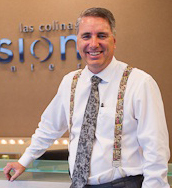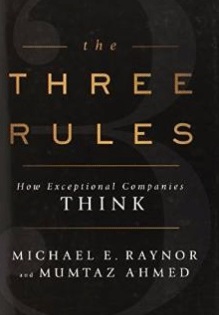By Ken Krivacic, OD, MBA

May 27, 2015
Creating value for our patients is a key to success, but we also must capture profit. We can increase profits by increasing prices or volume, or both, or by decreasing costs or reducing assets. Michael Raynor and Mumtaz Ahmed, the authors Three Rules: How Exceptional Companies Think, have discovered that exceptional companies have a common way of increasing profits–by putting revenues before cost. This means that when exceptional companies increase revenue, they do it by increasing investment in their company, rather than by cost-cutting, even if it means incurring higher costs.
 This article is based on the rule, “Revenue Before Cost,” highlighted in the book, Three Rules: How Exceptional Companies Think, by Micheal Raynor and Mumtaz Ahmed.
This article is based on the rule, “Revenue Before Cost,” highlighted in the book, Three Rules: How Exceptional Companies Think, by Micheal Raynor and Mumtaz Ahmed.
These authors set out to discover how some companies survive and thrive while others fade away and die. They analyzed 45 years of data on nearly 25,000 companies for their research, and used data from 1966 to 2010 to determine why some companies grow and others go out of business. They discovered three rules of management that differentiated profitable from less profitable companies.
I recently showed, in the ROB articles, Three Rules to Make Your Practice Greater, and Better Before Cheaper: Profit in Investing in Quality, how I have applied the concepts in this book to my own practice.
I like the three rules because they simplify things. As owners and leaders in our practices, we have a myriad of decisions to make every day about how best to run our practices. Use these three rules to guide you in your decision making processes, and make your practice life simpler and more profitable.–Ken Krivacic, OD, MBA
Invest in Advanced Optical Products
Carrying upscale, advanced products in the optical usually generates greater profits. A simple example would be frames. A wholesale cost of a frame that you purchased for $25, and marked up 3x, results in a profit of $50. Compare that to a frame you purchased for $50 and marked up 3x. That frame garners a profit of $100. In this simple example, doubling your cost resulted in doubling your profits.
Of course, there are exceptions to the rule. You could purchase even less expensive frames and mark them up much higher, such as a $10 wholesale frame. You would have to mark the frame up 11x to equal the profit of marking up the $50 frame 3x. Raynor and Ahmed note that once you start playing in the lower-end categories there usually is someone who will come along and undercut you. It can be done, but it is much wiser to compete on non-price factors to build your practice.
In our practice, for example,we brought in a low-end frame line that we coulddo a hefty mark-up onand still offer as a low-end cost alternative. We did this for several months, but discontinuedthe frame linedue to patients returning frames that broke or constantly needed adjustments. Sure, we could have continued the process because the mark-up was good, but we decided to discontinue the frame line because our opticians complained about the above-average amount of time involved with working with patientswho bought those frames.
We also worried that selling an inferior brand or product would lessen our brand. It had taken years to position ourselves as providers of nicer frames, and wedidn’t want to undo all that work because we wanted a low-end alternative for our patients. In effect, we said: “If you want something cheap, you’ll need to buy it somewhere else.”
Invest in High-Performing Staff
Staff costs are one of the largest costs a practice incurs, usually second only to cost of goods. There is a temptation to cut staff during tough economic times. Yet what kind of message does that send to our patients? Are they going to have to wait longer than usual because we are short staffed? Are they going to have a less-than-stellar experience because you have hired someone you could pay less than the topnotch candidate for the position? Will patients sense the tension in the office due to being short staffed?
I prefer to look at employees as an investment, rather than an expense. What do I mean by that? A good employee can earn more for a practice than they are paid by growing both the practice and the practice revenue. Here are some tips for aligning the investment in employees with the theme of Revenue Before Cost:
• Hire the best person for the position, not the one you can pay the least.
• Don’t cut employee hours to reduce payroll, look for ways to make staff more efficient.
• Track revenue-per-staff payroll. Most metrics say that should be in the vicinity of $150,000/per staff person per year.
• If you do have to cut a staff member, replace them with a better, more efficient staffer, and constantly invest in your staffby offering:
Training – both clinical and customer service
Regular weekly staff meetings
Regular bi-annual company retreats (full-day offsite meetings)
Bonus plans and pay
Regular and spontaneous reviews
Try to Avoid Cutting Costs In Challenging Financial Times
“There Are No Other Rules,” another concept from Raynor and Ahmed, emphasizes that when times get tough, or profits are shrinking, you want to avoid the natural inclination to hunker down and carry less expensive products or cut costs in other areas, and, instead, to reaffirm your investment in quality products, staff and patient experience.
In our practice, we have tried to continue to be true to our focus. By that I mean if you are a high-end practice, stay high end when economic times are difficult. Resist the temptation to start promoting cheaper services or products. This will only dilute your brand and confuse your existing and potential patients. By contrast, if you are a lower-endhigher-volume type of practice, do not suddenly try to sell high-end products. There is more than one way to be successful in practice, but you need to stick to what works and not confuse your patients and staff on what the practice is known for.
An example of this philosophy happened for us a few years ago. We made the decision to upgrade our phoropters to the new digital phoropters. If we had based our decision on cost alone we would not have made this purchase as these units are much pricier than a standard phoropter, yet they helped grow our revenue by improving our practice image. Patients commented on the new equipment and how they had not ever had an exam with that type of equipment before. For the patient, it showed that we keep up with the latest technologies and our office wants to ensure that they have the best optometric experience possible.
From the perspective of the practice, even though we spent more on a piece of equipment that does a basic function, we have gained by a consistent increase of revenue in our optical sales. Our optical department has revenues of just over 1 million per year that has grown by just over 3 percent ever year that we have had the new digital phoropters. Granted, the phoropters were not the only reason for the growth, but they have helped and they have enhanced the image of our practice in the patient’s eyes.
Related ROB Articles
Six ROI Winners for Your Practice
Four Ways to Add Direct-Pay Products & Services
Six Steps to Achieve and Maintain a High Per-Patient Revenue
Ken Krivacic, OD, is the owner of Las Colinas Vision Center in Irving, Texas. To contact him: kkrivacic@aol.com.

























